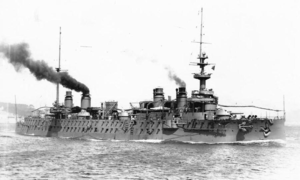French cruiser Condé
 Sister ship Gloire in 1913
| |
| History | |
|---|---|
| Name | Condé |
| Namesake | Louis, Grand Condé |
| Builder | Arsenal de Lorient |
| Cost | 23,000,000f |
| Laid down | 20 March 1901 |
| Launched | 12 March 1902 |
| Completed | 12 August 1904 |
| Decommissioned | 1933 |
| Fate | Sunk, 1944 |
| General characteristics | |
| Class and type | Template:Sclass- |
| Displacement | 10,223 metric tons (10,062 long tons) |
| Length | 139.8 m (458 ft 8 in) |
| Beam | 20.2 m (66 ft 3 in) |
| Draft | 7.7 m (25 ft) |
| Installed power |
|
| Propulsion | 3 Shafts, 3 vertical triple-expansion steam engines |
| Speed | 21 knots (39 km/h; 24 mph) |
| Range | 12,000 nautical miles (22,000 km; 14,000 mi) at 10 knots (19 km/h; 12 mph) |
| Complement | 612 |
| Armament |
|
| Armor |
|
The French cruiser Condé was one of five Template:Sclass- armored cruisers built for the French Navy in the early 1900s.
Design and description

The Gloire-class ships were designed as enlarged and improved versions of the Template:Sclass- armored cruisers by Emile Bertin.[1] The ship measured 139.8 meters (458 ft 8 in) overall, with a beam of 20.2 meters (66 ft 3 in). Condé had a draft of 7.7 meters (25 ft 3 in)[2] and displaced 10,223 metric tons (10,062 long tons).[3]
The ship had three vertical triple-expansion steam engines, each driving one propeller shaft. The engines were rated at a total of 20,500 indicated horsepower (15,300 kW), using steam provided by 28 Niclausse boilers. She had a designed speed of 21.5 knots (39.8 km/h; 24.7 mph).[2] She carried up to 1,590 long tons (1,620 t) of coal[1] and could steam for 12,000 nautical miles (22,000 km; 14,000 mi) at a speed of 10 knots (19 km/h; 12 mph).[2]
Condé's main armament consisted of two 194 mm (7.6 in) guns mounted in single-gun turrets fore and aft. Her intermediate armament was eight 164 mm (6.5 in) guns. Four of these were in single gun turrets on the sides of the ship and the other four were in casemates. For anti-torpedo boat defense, she carried six 100 mm (3.9 in) guns in casemates and eighteen 47 mm (1.9 in) Hotchkiss guns. She was also armed with five 450-millimeter (17.7 in) torpedo tubes; two of these were submerged and the others were above water.[1]
The waterline armored belt of the Gloire-class ships was 170 millimeters (6.7 in) thick amidships and tapered to 106 millimeters (4.2 in) towards the bow and stern. Above the main belt was a thinner strake of armor, 127 millimeters (5 in) thick that also tapered to 106 mm at the ends of the ship.[4] The conning tower had armored sides 150 millimeters (5.9 in) thick. The main gun turrets were protected by 173 millimeters (6.8 in)[2] of armor and the intermediate turrets by 120 millimeters (4.7 in). The flat part of the lower armored deck was 45 millimeters (1.8 in), but increased to 64 millimeters (2.5 in) as it sloped down to the sides of the ship.[4]
Construction and career
Condé, named after Louis, Grand Condé[5] was laid down at the Arsenal de Lorient on 20 March 1901, and was launched on 12 March 1902, having been less than a year on the stocks.[6] She was completed on 12 August 1904.[5]
In 1914 she was in the Gulf of Mexico, during the United States occupation of Veracruz.[7] She was hulked at Lorient in 1933, and captured by the Germans in 1940, who used her as a submarine depot ship. She was sunk by aircraft in 1944.[5]
Notes
- ^ a b c French Armored Cruiser Sully, pp. 324, 326
- ^ a b c d Silverstone, p. 80
- ^ Gardiner, p. 305
- ^ a b French Armored Cruiser Sully, p. 326
- ^ a b c Silverstone, p. 94
- ^ "Naval & Military intelligence". The Times. No. 36717. London. 17 March 1902. p. 10. template uses deprecated parameter(s) (help)
- ^ Log of the HMS Berwick
References
- "French Armored Cruiser Sully". Warship International. V (4). Toledo, Ohio: Naval Records Club: 324–26. 1968. ISSN 0043-0374.
- Gardiner, Robert, ed. (1979). Conway's All the World's Fighting Ships 1860–1905. Greenwich, UK: Conway Maritime Press. ISBN 0-8317-0302-4.
- Silverstone, Paul H. (1984). Directory of the World's Capital Ships. New York: Hippocrene Books. ISBN 0-88254-979-0.
External links
